G2045
Abiotic Diseases of Sugarbeets in Nebraska
Abiotic diseases — those caused by environmental conditions — can be confused with symptoms caused by biotic diseases or pests. This NebGuide helps identify abiotic stresses that can occur in sugarbeets and helps distinguish them from those caused by pathogens.
Robert M. Harveson, Extension Plant Pathologist
C. Dean Yonts, Extension Irrigation Engineer
- Water Stress — Deficit
- Water Stress — Surplus
- Hail Damage
- Wind Damage
- Freeze Damage
- Soil Compaction
- Animals
- Genetic Disorders
- Herbicide Damage
Plant diseases generally are classified as either biotic (caused by a pathogenic parasite) or abiotic (caused by environmental conditions such as wind, water, and temperature, or genetic disorders). More importantly, abiotic diseases also may cause symptoms that may be confused with symptoms caused by biotic diseases or pests. This publication is intended to help identify abiotic stresses that may occur in sugarbeet and distinguish them from those caused by pathogenic agents. This will facilitate implementation of proper management strategies.
Water Stress — Deficit
Symptoms of water stress can occur if soil (Figure 1) water is lacking or if evaporative demands of the atmosphere exceed the ability of the plant to transpire water. In both cases, plant leaves wilt, but if caused by a lack of water in the soil, symptoms will extend further into the evening hours. Symptoms of water stress normally begin to appear during the afternoon when temperatures are high. Water stress conditions can occur anytime during the growing season. If rainfall occurs or irrigation is applied within a few days of the onset of water stress, the condition is temporary and only minor wilting of leaves occurs. However, if the condition is prolonged, young seedlings may die while the older leaves on more mature plants will die first, resulting in reduced yields.
Because the root system of new seedlings (Figure 2) is limited, water stress occurs quickly and can be seen affecting the entire plant. On more mature plants, older leaves tend to wilt first and lay on the soil surface while younger leaves may remain more upright. Leaves in prolonged contact with the hot soil surface can become scorched and eventually dry. When water stress is relieved and leaves return to an upright position (Figure 3), leaf scorch may be confused with other foliar diseases such as bacterial leaf spot (Figure 4). Many of the newer sugarbeet varieties do not exhibit extreme leaf wilting when water stress occurs.
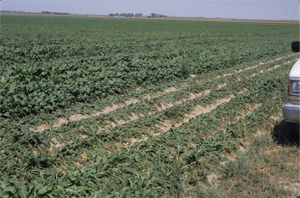 |
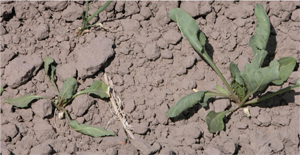 |
|
Figure 1. Drought symptoms in sugarbeet — note irrigation row effects. Water did not move properly down rows near truck. |
Figure 2. Effects of drought on younger plant on left compared to older plant on right. Older plant is better able to extend deeper into soil to extract water. | |
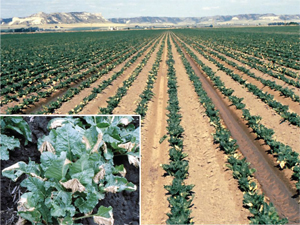 |
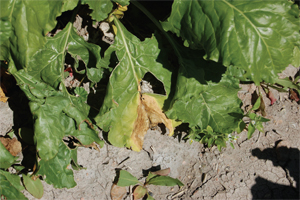 |
|
| Figure 3. Leaf scorch on plant in the morning as a result of afternoon wilting and leaves touching soil surface the previous day. | Figure 4. Damage caused by bacterial leaf spot that may be confused with leaf scorch. |
Wilting of leaves also may be a symptom associated with root pathogens. If roots are infected by the pathogens causing rhizomania or Aphanomyces root rot, irrigating may compound the problem by increasing the water content of the soil and causing the root environment to be more favorable to disease development. These two problems can be distinguished by making evaluations during morning hours. Both water stress and root diseases will cause wilting symptoms during the afternoon, but if plants are still wilted early the next morning, they are likely not affected by a water deficit.
Water Stress — Surplus
Too much water also can cause problems for sugarbeet production. When soil temperatures are high and plants are exposed to saturated soils for several days, roots can rot due to lack of oxygen movement into root tips. This often occurs in low areas of fields where water stands in shallow depths (Figure 5B). Foliage wilts suddenly and permanently, and the taproot will disintegrate into a wet, slimy rot (Figure 5A). Rotted roots also may exhibit an odor of fermentation, also due to lack of oxygen in the soil surrounding the root zone. These symptoms can easily be confused with effects of other root rotting pathogens such as Rhizoctonia solani, Aphanomyces cochlioides, or Pythium spp.
Hail Damage
Hail can cause plant damage that ranges from virtually undetectable to complete defoliation of all leaf material. Unless the hail occurs when the plants are seedlings, the beets will almost always recover and continue growing. However, both root yield and sucrose concentration can be significantly reduced due to the plant putting its energy into producing more leaves rather than building sugar in the roots. Moderate damage from hail will be seen as holes in the leaves or tears along the leaf edges. Severe damage occurs when the intensity or size of hailstones increases. Complete defoliation of plants is not uncommon (Figure 6).
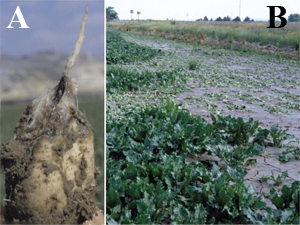 |
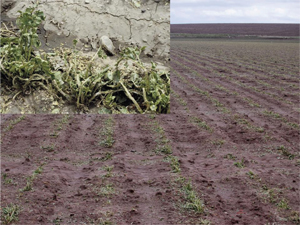 |
|
| Figure 5. (A) Anaerobic rot of sugarbeet root after prolonged exposure to flooded conditions. (B) Waterlogging symptoms in sugarbeet as a result of water standing in low area of field for prolonged period. | Figure 6. Severe hail damage in sugarbeet. |
Wind Damage
High winds from a storm can affect plants of any age, but the greatest potential for damage occurs in the early stages of growth before plants cover the soil. This damage is often associated with soil particles being blown across the soil surface. In extreme cases, portions of the root system may be exposed as soil is removed or small plants may be buried by soil deposits (Figure 7).
High winds in the spring also may contribute indirectly to sugarbeet stand loss in combination with early season Aphanomyces seedling disease. Even if conditions become unfavorable for continued seedling disease development, severely affected seedlings may be more susceptible to breakage by the wind and death due to thin, delicate stems (Figure 8). In addition, prolonged periods of wind also may cause plant girdling. Girdling results from the oscillation of plants back and forth in the wind, causing a breakdown of the hypocotyl or root tissue near the soil line (Figure 9).
Freeze Damage
Sugarbeets are sensitive to temperatures of 28°F (-2°C) or lower until true leaves have developed. Freeze damage to seedlings causes aboveground parts to become dry and necrotic, and may be confused with symptoms of damping-off. The primary difference is that below the frost line the roots of frost-damaged plants appear healthy (Figure 10A), whereas infected plants exhibit necrotic, diseased roots belowground (Figure 11).
The canopy of leaves of older plants provides protection to the crown and root, so the first freeze in the fall normally will affect only the foliage (Figure 12). Once the mature foliage has been frozen down, additional freezing temperatures will extend freeze damage into the crown and portions of the root. In mature plants, freezing damage may either be confined to the foliage or extend into the crown and aboveground portions of the root or to the freezing line belowground (Figure 10B). After thawing, frozen root tissue becomes soft and water-soaked.
 |
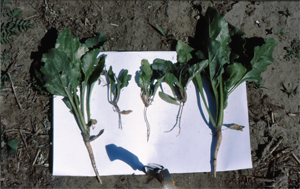 |
|
| Figure 7. Wind damage to young sugarbeet seedlings not protected with cover crop or residue. | Figure 8. Young sugarbeet plants (middle) infected by Aphanomyces cochlioides. Thin delicate stems are more susceptible to death and stand loss from wind. | |
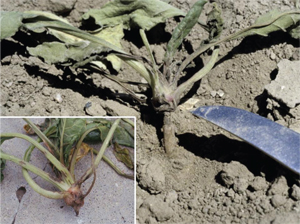 |
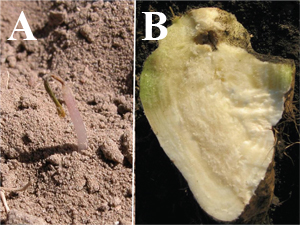 |
|
| Figure 9. Wind damage — girdling of young sugarbeet plant, and stem breakage (inset). | Figure 10. (A) Freeze damage to sugarbeet seedling; note healthy tissue below soil level. (B) Freeze damage to sugarbeet root; note healthy white tissue on bottom below freeze line (Photo courtesy American Crystal). | |
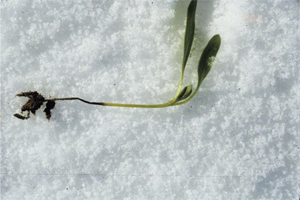 |
 |
|
| Figure 11. Sugarbeet seedling affected by postemergent damping off (Aphanomyces seedling disease). | Figure 12. Freeze damage to sugarbeet foliage. |
Soil Compaction
A layer of compact soil or a plowpan (a compacted layer formed in the soil directly below the plowed layer) may restrict the growth of taproots, causing roots to grow at a right angle to the plant’s axis (Figure 13), or severely restricting taproots and causing them to sprangle (spread out in different directions). Soils that tend to compact should be deep-tilled or in row ripped prior to planting to break up the compacted layer and allow water and roots to penetrate into the subsoil.
Animals
Several species of rodents, such as mice, voles, gophers, squirrels, and rabbits may cause severe damage by eating beet plants. Evidence of a rodent infestation consists of roots with hollowed-out areas (Figure 14), a rodent burrow, or a mound of soil and dead or dying plants.
Large populations of rodents, particularly mice, also can affect stand establishment in some situations. The mice dig up seeds and eat the internal contents before emergence (Figure 15). Some field studies found that pelleted seed was targeted, leaving raw seed unaffected. This was readily noticed with small holes in the soil beds with cracked, empty seed shells scattered about on the soil surface.
 |
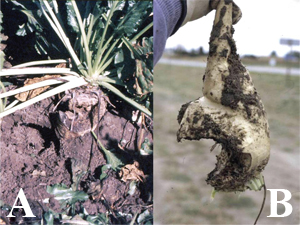 |
|
| Figure 13. Sugarbeet root affected by soil compaction. | Figure 14. Damage to mature sugarbeet roots from rodents. |
Genetic Disorders
Genetic changes in color that can occur in sugarbeet include chimeras and leaf spotting, yellowing, or color changes in leaves (or sometimes roots). Most cause no significant damage. These aberrations can be heritable and result from mutations or from outcrossing during seed production. Chimeras are among the most common genetic disorders and are the result of point mutations in plant cells. Because they may occur at any time in development (Figure 16A), the variegated appearance of the plant leaves may be a small sector or half of a leaf. In leaf tissues, it may cause a loss of chlorophyll, giving the leaf a white to yellow variegation (Figure 16B).
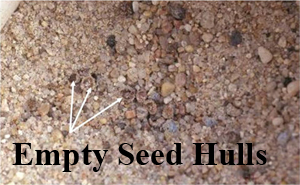 |
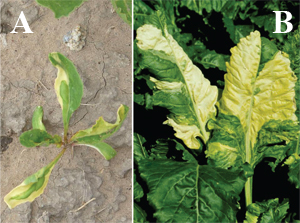 |
|
Figure 15. Damage from mice — seeds dug up and contents eaten. |
Figure 16. Genetic chimera in sugarbeet (A) young plant, (B) mature plants |
Herbicide Damage
Injury to sugarbeets also can occur from herbicides applied or carried over in the soil. Symptoms can vary tremendously (Figure 17) depending upon the chemical (mode of action) applied, or which part of the plant comes into contact with the product. In some cases, symptoms may be confused with other disease problems, such as beet curly top (Figure 18).
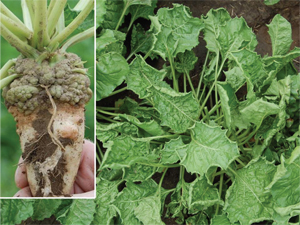 |
 |
|
| Figure 17. Herbicide carry-over damage in sugarbeet from a growth regulator (Tordon®) sprayed the previous year for Canada thistle control. | Figure 18. Curly top of sugarbeet; may be confused with herbicide injury such as that shown in Figure 17. |
This publication has been peer reviewed.
Disclaimer Reference to commercial products or trade names is made with the understanding that no discrimination is intended of those not mentioned and no endorsement by University of Nebraska–Lincoln Extension is implied for those mentioned. |
Visit the University of Nebraska–Lincoln Extension Publications Web site for more publications.
Index: Plant Diseases
Sugarbeet
Issued January 2011